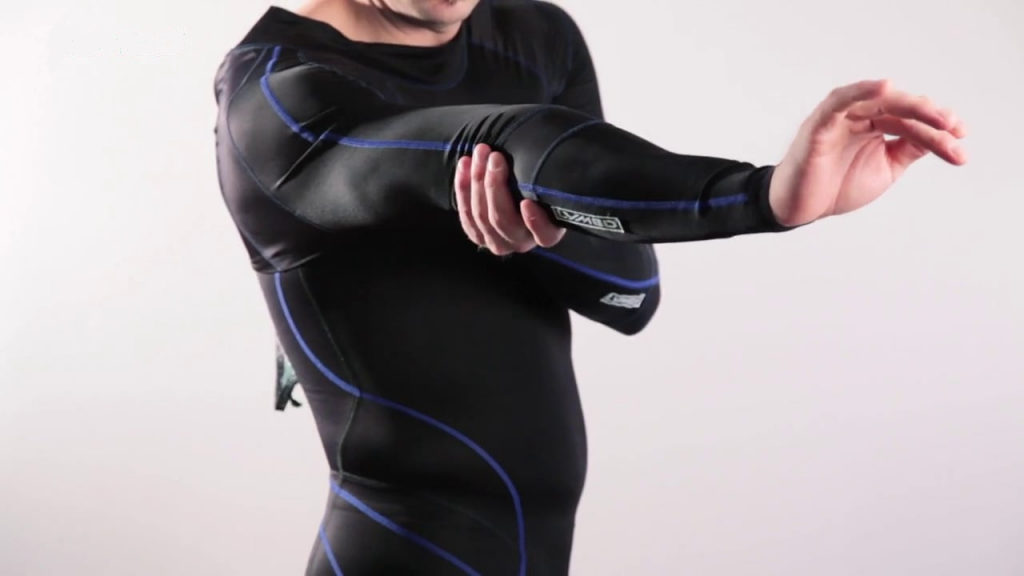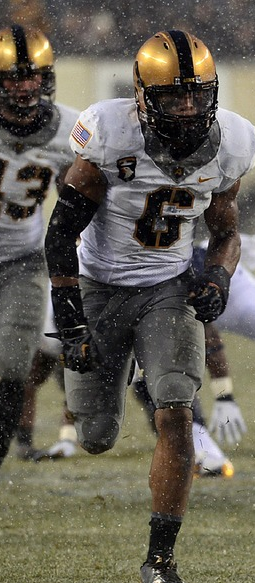
Made popular under runners, compression garments (and in particular compression socks) are often seen in public parks. There is a lot of variation in compression clothing, ranging from full body armors to skirts, pants or sleeves and tubes. Runners often use calf sleeves or calf socks whereas American football and basketball players often use arm sleeves.
Compression garments are often used during sport but are also a popular recovery method. The usage of compression clothing is a remedy going back decades, and is used to reduce edema. The external pressure built up by the garment or bandage promotes blood flow and keeps fluid from leaking in to the tissue, making it easier to pump the fluid up again. Because the compression clothing is so effective in building up pressure it is often used for the treatment of lymph edema, thrombosis and insufficient veins.
Promoting blood flow and reducing edema are two characteristics which could be beneficial for athletes. A more efficient blood flow could result in a faster clear out of waste products and reducing edema could be useful to decrease inflammation.
Muscle damage.
To measure muscle damage researchers often use blood testing looking at markers which indicate damage. Creatine kinase (CK) is one of those markers, CK is a the enzyme responsible for turning creatine phosphate (CP) and adenosine diphosphate (ADP) into adenosine triphosphate (ATP) which is than broken down to make energy for muscle function. CK sits inside muscle tissue, when you train hard the muscle gets damaged resulting in CK ending up in the blood stream. This is a objective way to measure muscle damage, this is why testing the blood for CK is very useful for researchers.
Studies looking at the influence of compression garments on CK levels produce varying results. There are some positive studies [6,9,10,20] but the majority of the studies sees no positive effect [1,3,7,15,16,21,23] making it hard to believe compression garments will restrict muscle damage.

The influence of compression clothing on performance.
There has been done quite a lot of research on the performance of athletes 1 to 5 days after a heavy training or match. Researchers put test subject through a heavy eccentric, plyometric or endurance training after which they were asked to wear compression socks, sleeves or shorts, comparing it to a control group. After 1 to 5 days (depending on the study) the test subject are asked to perform a series of tests to test performance. Think of short sprints (10-20m), counter movement jump, 1-km time trail or maximal isometric strength. Just as with CK this also produced varying results, there are some studies which produce positive outcomes [8,9,10,12,14,17,20] but most of them don’t see any positive effect [1,2,3,5,6,11,15,19,21,22,23]or even see a negative effect [2,7,11].
Positive effect on pain.
As for pain there is much positive news, because the great majority of the studies report a positive effect for pain sensation. It doesn’t matter what training session the test subjects are put through, almost every sport and type of training is tested in the various studies. From eccentric and plyometric to anaerobe and sport specific they all describe that participants wearing compression socks, sleeves or shorts experience less pain. The mechanism behind this effect remained to be discussed, a part of the researchers attribute it to a restricted inflammatory response and less tissue damage [6,9,10,22] but most of the researchers don’t see those effects [1,2,3,8,14,15,16,19,23]. The compression garment mostly having a mental effect is a other theory [15]. But you could also explain it with the gate-control theory in which the compression clothing is giving a constant stimulus to the sensible a-delta fibers which cause a overflowing amount of stimuli to the spinal cord causing the brain to ‘forget’ about the slow c-fiber pain.
Concluding:
If you want to decrease pain after a heavy training: compression socks, sleeves or shorts are a option. But it is not likely to help you repair muscle damage faster [1,3,5,6,15,19,21,22,23].
References:
- The effects of compression garments on recovery of muscle performance following high-intensity sprint and plyometric exercise
- The Effects of Compression Garments on Recovery
- The effects of compression garments on intermittent exercise performance and recovery on consecutive days.
- Compression Garments and Recovery from Eccentric Exercise: A P-MRS Study
- The effects of continuous external compression on delayed-onset muscle soreness (DOMS)
- Comparison of three types of full-body compression garments on throwing and repeat-sprint performance in cricket players
- The effects of contrast bathing and compression therapy on muscular performance.
- Efficacy of Lower Limb Compression and Combined Treatment of Manual Massage and Lower Limb Compression on Symptoms of Exercise-Induced Muscle Damage in Women
- Influence of compression therapy on symptoms following soft tissue injury from maximal eccentric exercise
- Continuous compression as an effective therapeutic intervention in treating eccentric-exercise induced muscle soreness
- The effect of recovery strategies on physical performance and cumulative fatigue in competitive basketball.
- Graduated compression stockings and delayed onset muscle soreness
- Do Compression Garments Enhance the Active Recovery Process after High-Intensity Running?
- Effect of Compression Garments on Short-Term Recovery of Repeated Sprint and 3-Km Running Performance in Rugby Union Players
- Effects of compression garments on recovery following intermittent exercise
- Influence of Compression Garments on Recovery After Marathon Running
- The effects of lower-body compression garments on recovery between exercise bouts in highly-trained cyclists
- Evaluation of the effectiveness of compression garments on autonomic nervous system recovery following exercise.
- Changes in Anaerobic Sprint Performance, Perceived Muscle Soreness and Sleep Quality after Wearing Compression Garments during Recovery from a Strength Training Workout
- Effect of calibrated lower body compression garments on recovery following an acute bout of exhaustive exercise
- Use of compression garments for recovery from plyometric exercise
- THE EFFECTS OF COMPRESSION GARMENTS ON THE RECOVERY OF LONG DISTANCE RUNNERS AFTER PROLONGED EXERCISE
- The Effects of Knee High Compression Garments and Ice on Exercise Performance and Recovery

Awesome article.